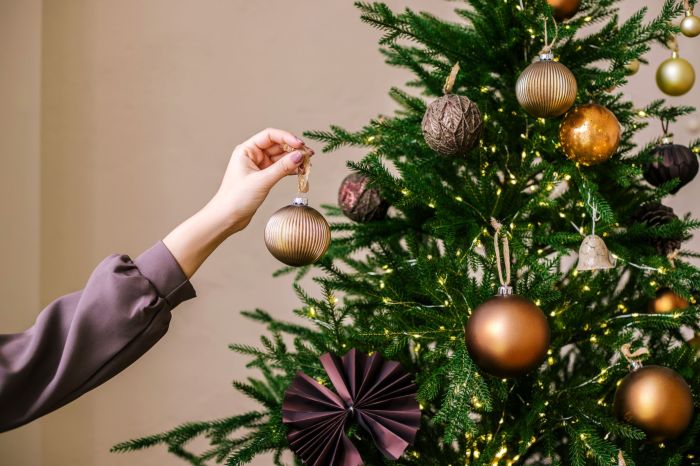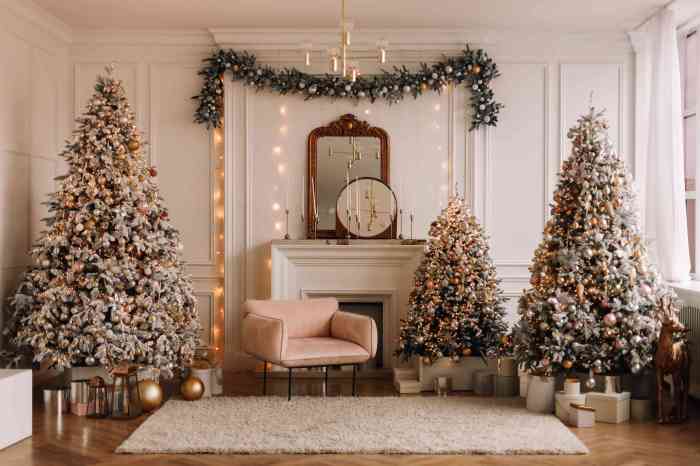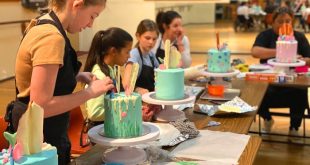A History of Christmas Tree Decorating
Christmas tree decorating – The tradition of decorating Christmas trees has evolved significantly over centuries, blending diverse cultural influences and evolving aesthetic preferences. From humble beginnings to the elaborate displays seen today, the Christmas tree’s journey reflects shifting social norms and artistic expression.
Early Christmas Tree Ornamentation and Cultural Influences
While the exact origins remain debated, the practice of decorating evergreen trees during the winter solstice predates Christianity, with evidence found in various pagan traditions. Early decorations were often simple, using natural materials like fruits, nuts, and candles. In 16th-century Germany, the first documented Christmas trees appeared, adorned with paper flowers, apples, and wafers. These early ornaments held symbolic meaning; apples represented the fruit of the Garden of Eden, while wafers symbolized the Eucharist.
The practice spread throughout Europe and eventually to other parts of the world, adapting to local customs and available resources.
Evolution of Christmas Tree Decorating Styles
The Victorian era witnessed a significant shift in Christmas tree decorating. The introduction of mass-produced glass ornaments from Germany, featuring intricate designs and vibrant colors, transformed the aesthetic. These ornaments, often depicting religious scenes, winter landscapes, or fairy-tale characters, became highly collectible. Early 20th-century innovations included electric lights, replacing the potentially hazardous candles, further enhancing the tree’s visual appeal.
Modern decorating styles encompass a vast range, from minimalist designs to maximalist displays, reflecting personal preferences and cultural trends. The use of sustainable and handcrafted ornaments has also gained popularity, reflecting a growing awareness of environmental concerns.
A Timeline of Key Milestones in Christmas Tree Decorating
A concise timeline helps illustrate the evolution of this cherished tradition:
- Pre-16th Century: Pagan traditions involving the decoration of evergreen trees during winter solstice.
- 16th Century: Emergence of decorated Christmas trees in Germany, using simple natural ornaments.
- 19th Century: Victorian era introduces mass-produced glass ornaments from Germany, significantly altering the aesthetic.
- Early 20th Century: Electric lights replace candles, enhancing safety and visual impact.
- Mid-20th Century to Present: Diversification of ornament styles, materials, and themes, reflecting evolving tastes and cultural influences. Increased emphasis on sustainability and personalized decorations.
Types of Christmas Trees
Choosing the right Christmas tree is crucial for setting the overall tone of your holiday decorations. The selection process involves considering various factors, including the type of tree, its size, shape, and needle type.
Real vs. Artificial Christmas Trees
The choice between a real and an artificial Christmas tree involves weighing several factors. Real trees offer a natural aroma and aesthetic, contributing to a more traditional festive atmosphere, while artificial trees provide convenience, longevity, and cost-effectiveness in the long run.
| Tree Type | Cost | Lifespan | Environmental Impact |
|---|---|---|---|
| Real | Variable, depending on size and species | One season | Potentially high carbon footprint depending on sourcing and disposal methods; some argue it offsets by using sustainable farms. |
| Artificial | Higher initial cost, but longer lifespan | Multiple seasons | High carbon footprint due to manufacturing and disposal; however, longevity can mitigate some impact. |
Choosing a Christmas Tree Based on Size, Shape, and Needle Type
Size considerations depend on the available space and desired visual impact. Shape influences the overall aesthetic, with conical, pyramidal, or irregular shapes offering distinct visual characteristics. Needle type affects the texture and feel of the tree, with different species exhibiting varying degrees of softness, length, and retention.
Ornament Selection and Placement
The art of ornament placement significantly impacts the overall visual appeal of the Christmas tree. Careful consideration of color schemes, themes, and styles contributes to a balanced and aesthetically pleasing display.
Creative Ornament Arrangement Ideas
Ornament arrangement can be approached in several ways: a monochromatic scheme creates a sense of elegance and sophistication; a themed approach, such as a winter wonderland or a rustic farmhouse, offers a cohesive and storytelling element; and a mix-and-match style allows for a more eclectic and playful presentation. Layering ornaments, starting with larger ones at the bottom and gradually decreasing in size towards the top, creates visual depth.
Clustering similar ornaments together adds visual interest and balance.
Step-by-Step Guide to Arranging Ornaments
- Start with the lights, ensuring even distribution across the tree.
- Place larger ornaments lower on the tree, creating a solid base.
- Gradually add medium-sized ornaments, alternating colors and styles.
- Incorporate smaller ornaments and embellishments to fill in gaps.
- Strategically place focal point ornaments, such as unique or heirloom pieces.
- Add finishing touches, such as ribbons, garland, and a tree topper.
Different Ornament Types and Their Suitability
Glass ornaments offer elegance and sophistication; plastic ornaments are durable and affordable; and handmade ornaments provide a personalized and sentimental touch. The choice depends on the desired aesthetic and the tree’s overall style.
The tradition of Christmas tree decorating varies across cultures, reflecting diverse aesthetic preferences and available resources. Finding the perfect tree often involves considering factors beyond mere aesthetics; for instance, securing stable housing is paramount, and families may need to explore options like those listed on this website for houses for rent that accept Section 8 to ensure a comfortable holiday season.
Ultimately, the joy of decorating the tree symbolizes the warmth and security of a home, regardless of its size or location.
Visual Guide: Ornament Placement Techniques
Layering: Start with larger ornaments at the bottom and gradually decrease in size towards the top.
Clustering: Group similar ornaments together to create visual interest and balance.
Alternating: Alternate colors and styles of ornaments to prevent monotony.
Lighting Techniques and Effects: Christmas Tree Decorating
Christmas tree lighting plays a vital role in shaping the overall mood and ambiance. The choice of light type and placement significantly impacts the visual appeal and festive atmosphere.
Types of Christmas Tree Lights and Their Advantages
LED lights are energy-efficient, long-lasting, and available in a wide range of colors and styles. Incandescent lights offer a warm, traditional glow but consume more energy and have a shorter lifespan. Fiber optic lights create a unique, shimmering effect. The choice depends on personal preferences and priorities.
Lighting Techniques to Create Various Moods
Warm and cozy ambiance is achieved using warm-white or amber LED lights, strategically placed to create a soft glow. A bright and festive atmosphere is created using a combination of colors and brighter lights, distributed more evenly across the tree. A minimalist approach might involve a single string of lights, creating a subtle and understated effect.
The tradition of Christmas tree decorating varies across cultures, reflecting diverse aesthetic preferences and symbolic interpretations. Finding the perfect space to display one’s decorated tree often influences the selection process, especially for those considering relocation, such as individuals searching for houses for rent in Bakersfield , where available living space may impact tree size and placement. Ultimately, the size and style of the Christmas tree are chosen to complement the overall festive ambiance of the home.
Importance of Light Placement and Its Effect on Appearance
Even light distribution is essential to avoid dark patches and ensure a visually appealing display. Strategic placement can highlight specific ornaments or areas of the tree, enhancing the overall aesthetic. Using different light colors in different sections can also create visual interest.
Safe Use and Installation of Christmas Tree Lights
Always inspect lights for damaged cords or bulbs before use. Never overload electrical outlets. Use timers to prevent lights from being left on unattended. Keep lights away from flammable materials.
Adding Finishing Touches
Finishing touches elevate the Christmas tree decoration to the next level, adding personality and enhancing the overall aesthetic appeal. These details create a cohesive and visually stunning display.
Various Finishing Touches and Their Placement, Christmas tree decorating
Tree toppers crown the tree, serving as a focal point. Ribbons add elegance and color, strategically placed to accentuate the ornaments. Garland drapes around the tree, adding texture and visual interest. These elements work together to create a harmonious and aesthetically pleasing effect.
Materials Needed for Finishing Touches
- Tree topper: A star, angel, or other decorative item placed at the top of the tree.
- Ribbons: Various widths and colors to add accents and visual interest.
- Garland: Artificial or natural garland to drape around the tree.
- Pine cones, berries, or other natural elements to enhance the rustic or natural aesthetic.
Examples of Unique and Creative Finishing Touches
Incorporating personalized ornaments, such as family photos or handcrafted items, adds a sentimental touch. Using unconventional materials, such as repurposed items or natural elements, adds a unique and eco-friendly element. The possibilities are limitless, depending on personal preferences and creativity.
Sustainable Decorating Practices
Environmentally conscious Christmas tree decorating involves choosing sustainable materials, reducing waste, and practicing responsible disposal methods. This approach minimizes the environmental impact of the holiday season.
Environmentally Friendly Alternatives

Source: hearstapps.com
Reusable ornaments reduce the need for disposable decorations. Recycled or upcycled materials can be used to create unique and personalized ornaments. Natural, biodegradable decorations, such as pinecones and dried fruit, offer an eco-friendly alternative to mass-produced items.
Reducing Waste Associated with Christmas Tree Decorating
Careful planning and mindful purchasing can minimize waste. Opting for reusable decorations reduces the need for disposable items. Properly disposing of old decorations and Christmas trees through recycling programs further minimizes environmental impact.
Tips for Responsible Disposal of Christmas Trees and Decorations

Source: thespruce.com
- Recycle or compost your real Christmas tree.
- Donate or repurpose reusable decorations.
- Dispose of non-recyclable decorations responsibly.
Thematic Decorations
Selecting a theme for your Christmas tree decoration creates a cohesive and visually appealing display. Different themes evoke distinct moods and aesthetics, allowing for personalized expression.
Various Christmas Themes and Their Associated Styles
A rustic theme uses natural elements, such as pinecones and wood slices, creating a warm and inviting atmosphere. A modern theme utilizes minimalist ornaments and clean lines, offering a sophisticated and contemporary feel. A traditional theme employs classic ornaments and color schemes, evoking a nostalgic and familiar aesthetic.
Creating a Cohesive Theme Using Ornaments, Lights, and Decorations
Careful selection of ornaments, lights, and other decorative elements is crucial for creating a unified and visually pleasing theme. Consistency in color palettes, styles, and materials ensures a cohesive and impactful display. Thematic elements should be integrated throughout the tree, from the ornaments to the finishing touches.
Visual Guide: Examples of Different Thematic Decorations
Rustic Theme: Natural elements such as pinecones, wood slices, and burlap ribbons. Warm-toned lights.
Modern Theme: Minimalist ornaments, metallic accents, and sleek lines. Cool-toned lights.
Traditional Theme: Classic red, green, and gold ornaments. Traditional string lights.
Query Resolution
How long should I keep my real Christmas tree up?
Most real Christmas trees last 3-4 weeks, depending on the species and how well you care for it.
How do I prevent my tree from drying out too quickly?
Keep the tree stand filled with water, and place it away from direct heat sources.
What’s the best way to dispose of my Christmas tree after the holidays?
Check with your local municipality for recycling programs or designated drop-off locations.
Can I reuse artificial Christmas tree lights year after year?
Yes, but inspect them carefully for any damage before each use. Replace any broken or frayed lights.
How can I store my ornaments safely after the holidays?
Wrap fragile ornaments individually and store them in labeled boxes in a cool, dry place.
 Interior Living
Interior Living
